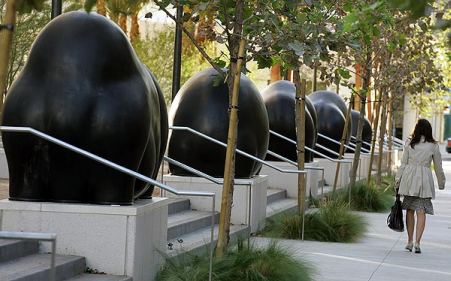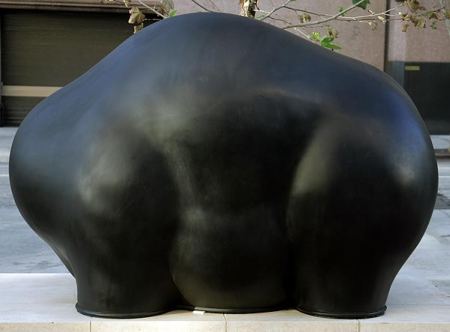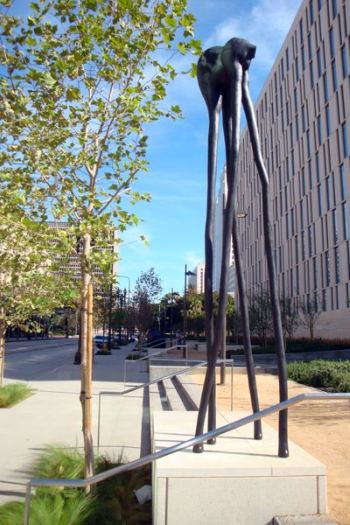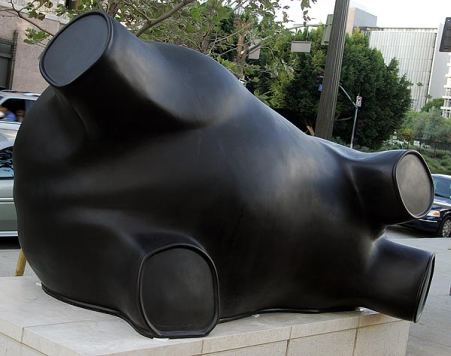In the west plaza of Seattle’s Safeco Field is a 5-ton granite boulder that sculptor Peter Shelton found in the Cascade range. It’s an object with the power to bring wilderness into the city.
Shelton honored it with a shadow, a black bronze replica that offers mass without weight. Woven on its surface are horizontal waves that respond to the surface nuances of the rock and answer its chaos with order. Titled “rockshadow,” the piece plays with the nature of inside and out, form and shadow, the real and fake, the found and created.
Despite the challenge of his subtlety, Shelton enjoys considerable success in the realm of public art. Controversies such as the current one over his sixbeaststwomonkeys, an ensemble of eight sculptures installed in front of the LAPD’s new headquarters, are rare.
(Photos LA Times)

 One of two bookends:
One of two bookends:
 LA Times columnist Steve Lopez kicked off the commentary with one of his I-wander-the-city essays. In a similar vein, his columns on homeless musician Nathaniel Ayers became a book and later a movie starring Robert Downey Jr. and Jamie Foxx. (In case somehow you missed it, NPR story on their friendship here. Good movie.)
LA Times columnist Steve Lopez kicked off the commentary with one of his I-wander-the-city essays. In a similar vein, his columns on homeless musician Nathaniel Ayers became a book and later a movie starring Robert Downey Jr. and Jamie Foxx. (In case somehow you missed it, NPR story on their friendship here. Good movie.)
Here’s Lopez on Shelton:
As luck would have it, the nearly completed LAPD headquarters is right outside my office window, so I’ve been bird-dogging the project from Day One to make sure taxpayers don’t get ripped off. Which brings me to the $500,000 worth of public art that’s just been installed on the west side of the building.
The cast-bronze sculptures consist of six large black blobs, with two tall, skinny structures on either side.
I wasn’t sure what to make of them, so I went straight to the top: It looks like “some kind of cow splat,” said Police Chief William J. Bratton, who sounded as if he were personally insulted by the installation.
Bratton said he first drove past the work and later walked back to see whether “it’s as ugly up close as it is when you’re driving by.”The answer was yes, and he sounded mad enough to have the artist arrested.
Lopez’s aw-shucks style appears to preclude research. If he did any, it’s not obvious. LA Times art critic Christopher Knight had to respond, but such responses are tricky. Knight cannot shoot inside his own building. While he can be tough as he wants on targets outside the Times, inside he treads lightly.
When my former PI colleague Scott Sunde was a young reporter in Dallas,
a man whose business practices Sunde was investigating said to him, “I
wish you’d cover my business the way you cover your own.”
In
other words, with baby’s breath and kid’s gloves. When I wanted to
reply in print to a fellow staffer’s piece of passive-aggressive
stupidity on a topic important to me, an editor advised me to look down and see whose jersey I was
wearing. Translation: If you’re on the PI team, you do not score
against teammates. Only if the disgrace is large enough to threaten the
institution are staff writers allowed to find fault with anything
published by other staff. (Famous example, Maureen Dowd on Judith Miller, here.) Starting in the 1990s, newspapers began to employ pubic public editors to do the job. Most proceeded to tiptoe.
That
context accounts for the lighthearted tone of Knight’s first foray.
Being the muscleman of art criticism, lighthearted does not come easy.
Knight:
In the annals of art criticism, deriding a sculpture as looking like “some kind of cow splat” is probably not bound for glory.
That was the colorful phrase used by outgoing LAPD Chief William J.
Bratton in reaction to “sixbeaststwomonkeys,” an ensemble of eight
sculptures by Peter Shelton commissioned for the department’s new
headquarters at First and Spring streets downtown and still being
installed as I write. (Dedication is set for Saturday between 10 a.m.
and 3 p.m.) The rebuke makes for an eye-catching headline.
But for reasons I’ll get to in a moment, it doesn’t even begin to come
close to the furor inspired by another benign sculpture commissioned
half a century ago for Parker Center, the LAPD’s old headquarters a few
blocks away.Neither does Bratton’s crack demonstrate that he knows zilch about
contemporary sculpture, as one might suspect; it demonstrates instead
that he doesn’t know much about cow splat. Born and raised in Boston,
the chief has lived and worked successfully on police forces there and
in New York City and Los Angeles, where encounters with cows are rare.
Perhaps he can be forgiven for not knowing what bovine poo actually
looks like. (more)
Ha
ha. The chief doesn’t know what cow shit looks like. Back to Lopez: Not satisfied with
the police chief’s free associations, he offered a couple of his
own, including:
But the animal on the northern end looked like a pig that had been knocked on its side.
In what was far from her finest hour, Seattle art critic Jen Graves quoted Lopez without mentioning him and promulgated the slander without addressing it:
Peter Shelton, whose work cloudsandclunkers is a really nice moment at Sea-Tac Airport, managed to install a pig on its side at LAPD headquarters–and the cops noticed. Tee hee.
 Not a pig, Jen. Who does she think Shelton is, Jack Daws?
Not a pig, Jen. Who does she think Shelton is, Jack Daws?
I imagine if given the chance, Daws would be happy to install a
sculpture with piggy associations in front of a police station.
Thrilled, actually.
Shelton’s work is about the odd poetry of
the malformed. He’s interested in what is not prime, what shuffles on
broken feet into a limelight of its own making. To Henry Moore’s
idealized celebrations, Shelton responds with the eloquent weight of the
time-battered body.
What saint strained so much,
Rose on such lopped limbs to a new life?
Scarlet Cheng interviewed Shelton last April, here. Worth reading for Shelton’s voice, but Cheng calls the piece in LA a whimsy. Shelton does not trade in whimsy.



Nailed it. Best thing I’ve read about Peter Shelton. I wish you’d stop writing about newspapers, though. This is an art blog. Readers don’t care about newspapers.
Three cheers for Steve Lopez* and Chief Bratton! Their remarks make more sense than all the savvy comments by critics (above and linked to) and by “sculptor” Peter Shelton combined. Bratton may not know “zilch” about so-called contemporary art, as Christopher Knight quips, may not be an “art expert” as Shelton has snidely observed, but that’s to his advantage.
Bratton’s statement that he likes the orange grove etching — http://tinyurl.com/GhostGrove — in the auditorium of the new Police Department headquarters better than Shelton’s work outside it because “it has some semblance of what it’s supposed to be—trees and leaves” alludes to the defining principle that all art is mimetic. That’s why Bratton says that he hasn’t “the faintest idea what the two tallest things are on either side” (at both ends) of Shelton’s six black forms. Compare this to Knight’s take on these two “headless creatures atop tall, spindly legs.” He doesn’t quite know what to make of them either, but that doesn’t stop him from observing that they are “presumably derived from the monkeys mentioned in the title.”
Knight is an art critic, and critics interpret, no matter what, so he conjures up the idea that these headless creatures — http://tinyurl.com/HeadlessCreatures — “twist in space as if scanning their surroundings with bodily sensors rather than eyes.” “These animated forms,” he adds, “begin and end the procession with an image of movement into the central city.” Now why didn’t poor Bratton think of all that!
* (For Lopez’s column, click on the link “an eye-catching headline” in the quote from Christopher Knight’s piece.)
Louis Torres, Co-Editor, Aristos (An Online Review of the Arts)
Don’t listen to Beth, Regina. I love your running commentary on the state of newspapers.